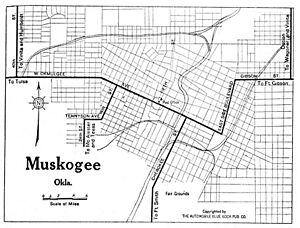History of Muskogee facts for kids
The history of Muskogee tells the story of the area where the city of Muskogee, Oklahoma is today. Muskogee's story began even before it officially became a city in 1898. Before it was a city, it was named to honor the Creek Nation in the 1800s. Later, it was opened up for new settlers during the Land Run.
Charles N. Haskell, who was from Ohio, helped make Muskogee a very important business center in eastern Oklahoma in the 1900s. Today, Muskogee has more than 38,000 people and is the eleventh largest city in the state.
Muskogee's Early Days: The 1800s
Muskogee first became known in 1805. That's when U.S. President Thomas Jefferson suggested to the United States Congress that a trading post should be built near where the city is now. French fur traders were already in the area before the United States bought the Louisiana Purchase. It's thought that the French set up a temporary village near Muskogee in 1806. However, the first lasting settlement was built in 1817. It was on the south side of the Verdigris River, north of Muskogee.
After the Indian Removal Act was passed in 1830, the Five Civilized Tribes had to move from their homes in the south. They traveled to Indian Territory on a difficult journey known as the Trail of Tears. Two of these tribes, the Cherokee and Creek, built new settlements near Muskogee. The town then became part of both Indian Nations.
After the American Civil War, people became interested in moving west again. For the first time, the United States government allowed railroads to be built on Indian land. In 1872, the Missouri-Kansas-Texas Railroad line reached this area. By 1889, Muskogee was growing in importance for business and politics. Because of this, a United States federal court was set up in the city. This was the first federal court that had power in Indian Territory and was actually located there. Before this, all legal cases were handled by a federal court in Fort Smith, Arkansas.
With a federal court in place, Indian Territory was opened to new settlers through special events called land runs. The town of Muskogee officially became a city on March 19, 1898.
Muskogee in the 1900s
Even though Muskogee was located where three rivers met and had lots of good farmland, it stayed fairly quiet for its first few years. In 1900, the town had a population of 4,254 people.
Muskogee started to become very important when Charles N. Haskell moved there from Ohio. When Haskell arrived in March 1901, he found a calm town of just over four thousand people. Haskell helped the town grow to more than 25,000 residents.
Haskell built the first five-story business building in Oklahoma Territory. He also helped organize and build most of the railroads that came into the city. He owned fourteen brick buildings in Muskogee. Because of his influence, Muskogee quickly became a major center for business and industry. Haskell often said he hoped Muskogee would become the "Queen City of the Southwest."
Many of Muskogee's streets in the downtown area still have their original brick. Old buildings from Haskell's time stand next to newer, modern buildings.
As Muskogee became more important for business, its political power also grew. The Civilized Tribes met in Muskogee on August 21, 1905. They wanted to create an Indian State called the State of Sequoyah. They wrote its constitution there, and Muskogee was planned to be its capital. However, U.S. President Theodore Roosevelt said no to the idea. So, the proposed State of Sequoyah was not recognized by the federal government. Instead, the State of Oklahoma joined the United States on November 16, 1907, as the 46th state.
During the Great Depression, many tenant farmers in Muskogee lost their homes. The price of cotton dropped a lot, which led to the 1933 Agricultural Adjustment Act. This law caused landowners to take land out of farming to get money from the government. Because of this, they often asked their tenant farmers to leave. That same year, thousands of these displaced farmers helped start the "Okie migration" to California.
Even with new government programs like the New Deal, the area's economy didn't fully recover until the military started building up before World War II.
Muskogee Today: The 2000s
By the 21st century, Muskogee had become a major economic hub for eastern Oklahoma. It had a population of over 38,000 people. The city operates the Port of Muskogee, which means ships can travel from the city all the way to the Gulf of Mexico.
In May 2008, the city elected John Tyler Hammons as mayor. He was one of the youngest mayors in American history at the time.
See also
 In Spanish: Historia de Muskogee para niños
In Spanish: Historia de Muskogee para niños



